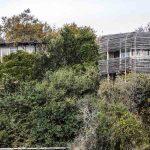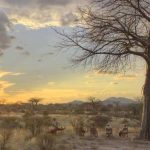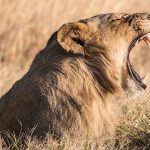First there was the cracking of branches breaking the silence over the riverbed. Then came the rustling of leaves and snapping of wood as the hulking figure moved in to view, munching on his latest meal.
How lovely to wake up to find an elephant in your backyard.
This elephant scene may have been something lots of other travellers had witnessed before me, but seeing it still felt like a major discovery.
I was watching from the veranda of my tent in Jongomero Camp, at the start of my very first safari, with little idea that I was about to be transfixed by a roll call of exotic animals, picking their way through Tanzania’s parched wilderness.
This bush-to-beach holiday crafted by the Selous Safari Company was about to take me through the wilds of the Ruaha National Park on the coast of east Africa. From Jongomero we would take a fear-inducing 90-minute light aircraft flight to the Selous Safari Camp on the fertile banks of the Rufiji River, before ending up at the charmingly romantic Ras Kutani beach resort, on the edge of a fresh water lagoon.
While my elephant sighting on day one may have made me feel like an intrepid pioneer, little did I know later that day I would see sleek zebras, giraffes, darting jackals, lumbering hippos, water buffalo, impalas galore and speedy vervet monkeys as we toured the park on the first of many game drives.
Our guides’ love of nature was infectious and rubbed off on all of us, making the sprawling game reserve feel intimate and accessible. Everything from the animals to the plants, and even the life and times of the termites, were weaved into a single easy-to-understand story, while we were out on safari walks, drives and boat rides.
There were so many magical moments on the trip, it felt as though they’d been fixed.
One morning we saw a pack of wild dogs – a worryingly endangered species – then as we sat down to lunch overlooking the water another afternoon, a dazzle of giraffes paraded past like they were headlining a catwalk show.
Naturally being on a group trip meant less time for individual excursions, but the staff would always try and accommodate your needs, even if they didn’t tie in with the rest of the gang.
This was how I found myself alone on a trek with veteran bushmen when the rest of my (tired) group had opted to go on another drive after our sunrise open air breakfast.
Gentle Musa had worked in the bush as a tracker and animal specialist for more than 33 years. It was like going for a walk with your unassuming granddad who just happens to be the Crocodile Dundee of the bush. He was full of pride and revelled in telling me some of the secrets of his trade.
He pointed out decaying skeletons of animals that once roamed nearby and how the elephants used a tree as a scrubbing brush. They sniffed the air to smell and spot creatures out in the distance, which to an untrained eye looked like part of the landscape.
Agog at the powerful creatures and unforgettable families of antelopes, monkeys and skulking jackals beneath twisted baobab trees, I was in awe at their insights and charmed by their care – and definitely glad I’d decided not to go on the drive.
Although we were definitely in the middle of nowhere, there was no stinting on comfort. In each camp, we stayed in homely boutique cloth cabins pitched under an enormous thatched roof and the food was a combination of elegant buffets, al fresco dinners under the stars, campfire cooking and classic safari picnics, all cooked by locals who gave the dishes a delicious East African flavour.
Musa told me: “Tanzania is not like other African countries. It’s not like Somalia or other places, we’re very friendly here. We want to do our best. It’s been like that all the way back to Nyerere [Dr Julius Nyerere – Tanzania’s first President].
“Everyone is welcome. With us, it’s many people, one table.”
By the end of trip, I realised I had begun to learn, albeit in some small way, to read the bush and our whole group agreed they’d been armed with useful insights that sharpened our senses as we reached our final game drive.
As the moment came, everyone was hungry for more animal sightings and we were not disappointed thanks to the quick wits of the driver who moved swiftly over the bumpy wild terrain.
We drove towards a herd of elephants in the distance. Then there was a muffled screech from our group and a raised arm pointing a finger in another direction.
It was only a fleeting glimpse, but it was a definitely a leopard.
Add this to the almost prehistoric-looking scene of grazing giraffes, brightly-coloured birds swooping into view and chortling hippos – and you’ve got the stuff that memories are made of.
KEY FACTS – SAFARI IN TANZANIA
:: BEST FOR: Those who want to see a huge range of creatures and get an insight into animal life in the African bush.
:: TIME TO GO: June to September when it’s dry and warm in order to see large concentrations of game on your walks. It’s hotter and greener from October to March, making it perfect for bird and plant lovers.
:: DON’T MISS: The thrill of being in the wild, a few feet from some of the most powerful and exciting creatures in the world.
:: NEED TO KNOW: Ask about vaccinations and possible malaria risk.
:: DON’T FORGET: The nights can be cool so bring some warm layers and socks.
TRAVEL FACTS
Helen William was a guest of The Selous Safari Company (www.selous.com) and stayed at Jongomero Camp, Selous Safari Camp and Ras Kutani.
Tanzania Odyssey reservations: www.tanzaniaodyssey.com.





